Cite this document
(Effects of Green and Blue Light on the Rate of Photosynthesis Lab Report Example | Topics and Well Written Essays - 1250 words - 1, n.d.)
Effects of Green and Blue Light on the Rate of Photosynthesis Lab Report Example | Topics and Well Written Essays - 1250 words - 1. https://studentshare.org/biology/1778671-effects-of-green-and-blue-light-on-the-rate-of-photosynthesis
Effects of Green and Blue Light on the Rate of Photosynthesis Lab Report Example | Topics and Well Written Essays - 1250 words - 1. https://studentshare.org/biology/1778671-effects-of-green-and-blue-light-on-the-rate-of-photosynthesis
(Effects of Green and Blue Light on the Rate of Photosynthesis Lab Report Example | Topics and Well Written Essays - 1250 Words - 1)
Effects of Green and Blue Light on the Rate of Photosynthesis Lab Report Example | Topics and Well Written Essays - 1250 Words - 1. https://studentshare.org/biology/1778671-effects-of-green-and-blue-light-on-the-rate-of-photosynthesis.
Effects of Green and Blue Light on the Rate of Photosynthesis Lab Report Example | Topics and Well Written Essays - 1250 Words - 1. https://studentshare.org/biology/1778671-effects-of-green-and-blue-light-on-the-rate-of-photosynthesis.
“Effects of Green and Blue Light on the Rate of Photosynthesis Lab Report Example | Topics and Well Written Essays - 1250 Words - 1”. https://studentshare.org/biology/1778671-effects-of-green-and-blue-light-on-the-rate-of-photosynthesis.


